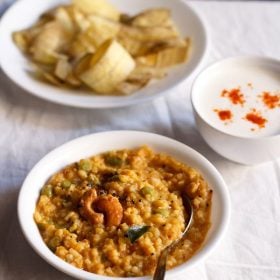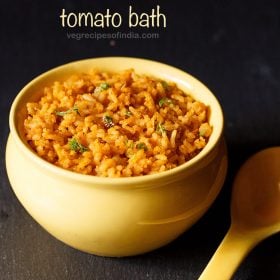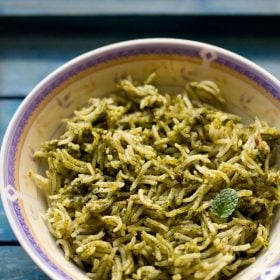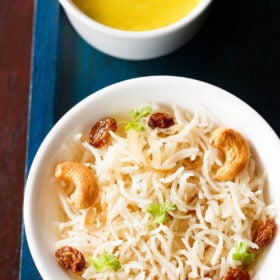Vangi Bath | Brinjal Rice (2 Ways)
The Marathi word for brinjal/eggplant/aubergine is ‘vangi’ and rice is ‘bath.’ Not taking a shower! So, when put together, it makes for this super flavorful and hearty Vangi Bath or Brinjal Rice. Not just in Maharashtra, a variation of Vangi Bath recipe is also popular in the cuisine of Karnataka. Both these regional versions have their own unique taste as some of the ingredients and spices used are different for both. Sharing my recipes for both types of this rice dish here.
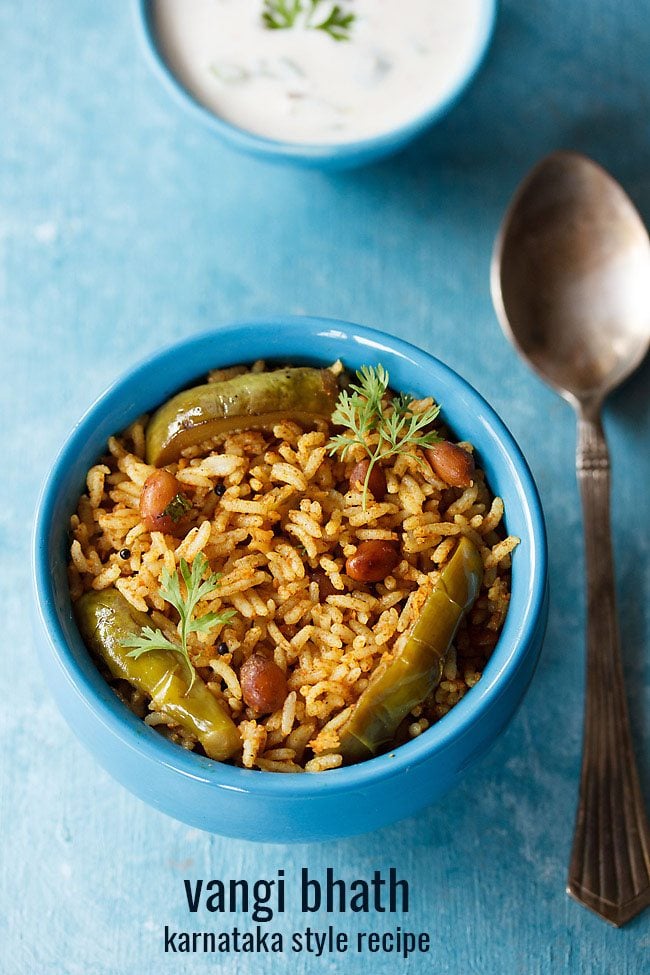
About Vangi Bath, Karnataka style
The main ingredients in the Karnataka style Vangi Bath recipe are a special Vangi Bath masala powder and tamarind pulp along with the eggplant and rice. I also used a typical sona masuri rice for the bath in this vegan Brinjal Rice. You can use any regular variety of rice.
In Karnataka, ‘bath’ may also be spelt as ‘bhath’ or ‘baath.’ Just know that both these words denote the same meaning, that is rice. Also, brinjal is called as ‘badanekai’ or ‘gulla’ in the local Kannada language of this state.
Preparing both these styles of Vangi Bath is very simple. For this variation, proceed by cooking the rice first and preparing the brinjal gravy next. Then, just mix the cooked rice with the brinjal gravy. If you have leftover rice with you, then this Brinjal Rice becomes quicker to prepare.
In the Karnataka special Vangi Bath recipe, usually green brinjals are used. However, you can make it with purple or purple striped brinjals which are fresh and tender. This Brinjal Rice recipe is also a no onion, no garlic one. Wish to add onions? Go ahead, do that.
The taste of the dish highly depends on the quality of the Vangi Bath masala. So, always use a premium quality store-bought one or better, a homemade one. In this Vangi Bath recipe, I have used an organic brand of the readymade masala powder.
Step-by-Step Guide
How to make Vangi Bath (Karnataka style)
Preparation
1. First, soak 1 heaped cup rice in water for 30 minutes. Use any regular rice. I used sona masuri rice.
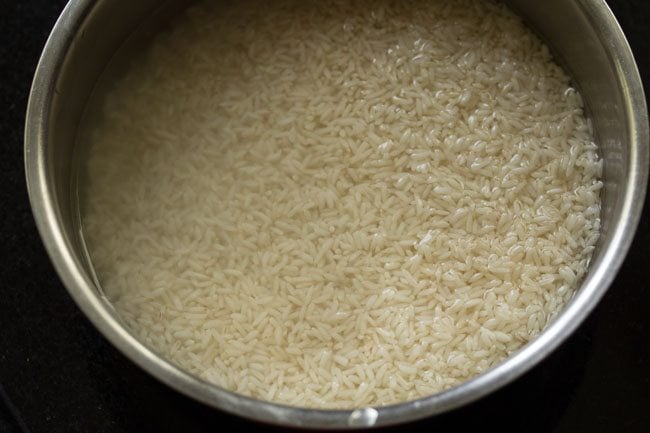
2. Then, pressure cook the rice with 2 cups water and ¼ teaspoon salt for 3 to 4 whistles or 11 to 12 minutes on medium heat. You can also cook the rice in a pot. If cooking in a pot, then you may need to add more water. Depending on the quality of rice, you can cook for 2 whistles or 9 to 10 minutes.
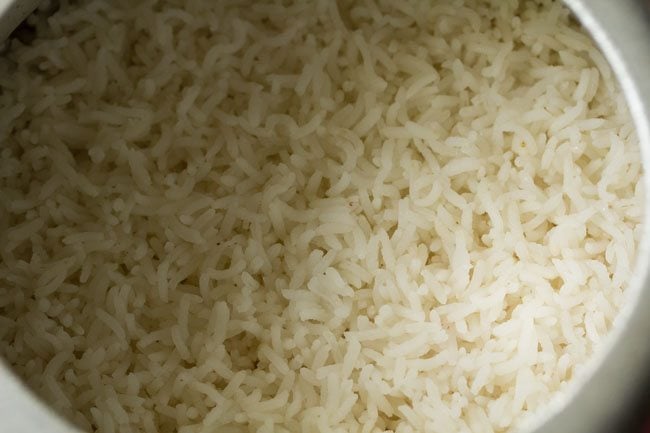
3. Soak ½ tablespoon tightly packed tamarind in ¼ cup hot water for 20 to 30 minutes.
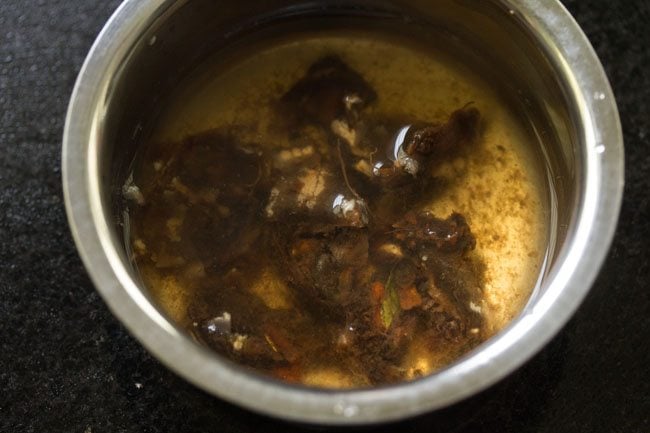
4. Later, squeeze the soaked tamarind in the water to get the tamarind pulp. Strain and keep aside.
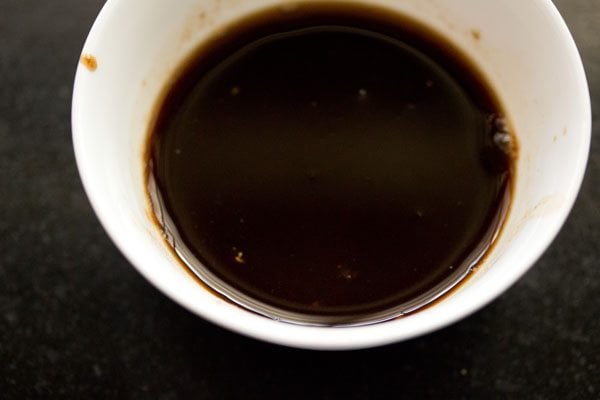
5. When the pressure settles down naturally, open the cooker’s lid and fluff the rice. You can allow the rice to cool in the cooker itself or spread it on a large plate/thali or tray. Allow the cooked rice grains to become warm or cool down. Cover and keep so that the rice grains do not dry out. The cooked rice grains should be separate.
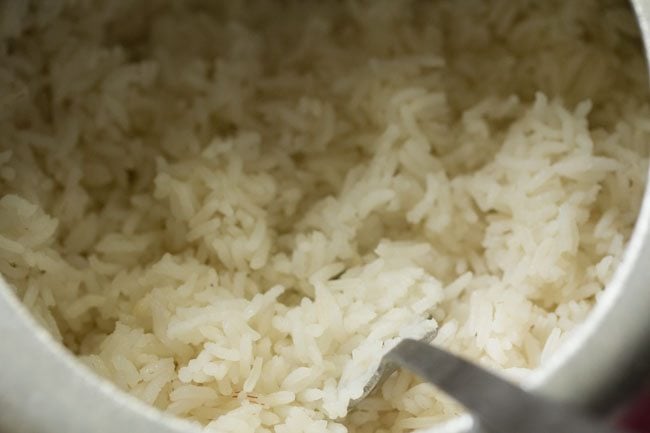
6. While the rice is cooking, rinse, remove the crowns of the brinjals (vangi or baingan) and slice them vertically in 4 pieces. As soon as you chop them, place them in a bowl containing water to which some salt has been added. Do make sure that there is sufficient water covering the brinjals. Allow them to be in the salted water for 15 to 20 minutes.
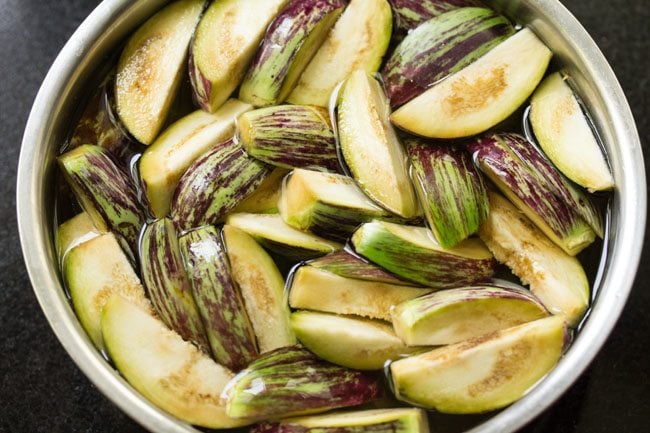
Making Vangi Bath, Karnataka style
7. Heat 2 tablespoons peanut oil ( you can also use sesame oil or sunflower oil) in a pan or kadai. Add ½ teaspoon mustard seeds.
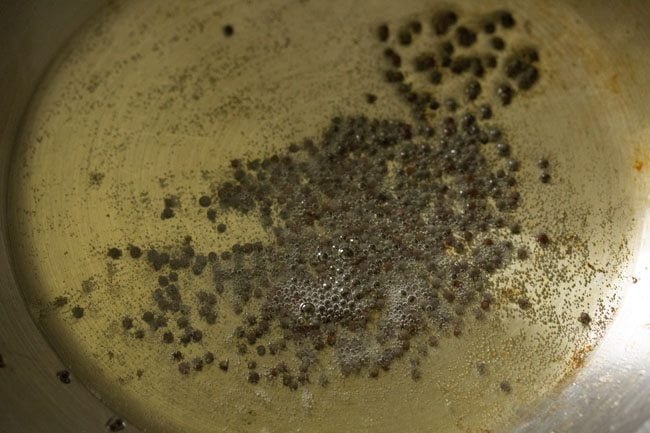
8. Once the mustard seeds begin to crackle, add ½ teaspoon urad dal.
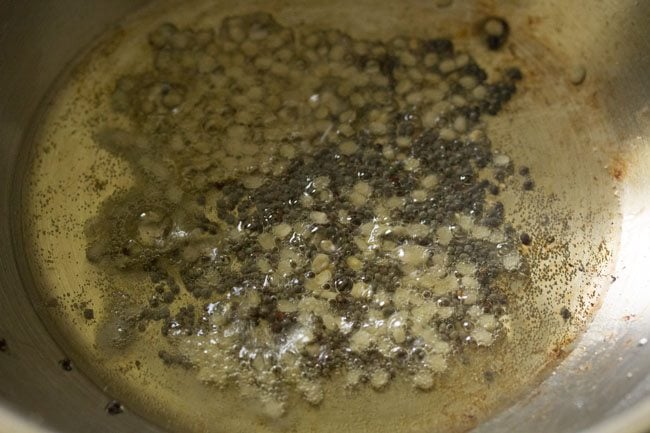
9. Next, add 2 tablespoons roasted peanuts or cashews.
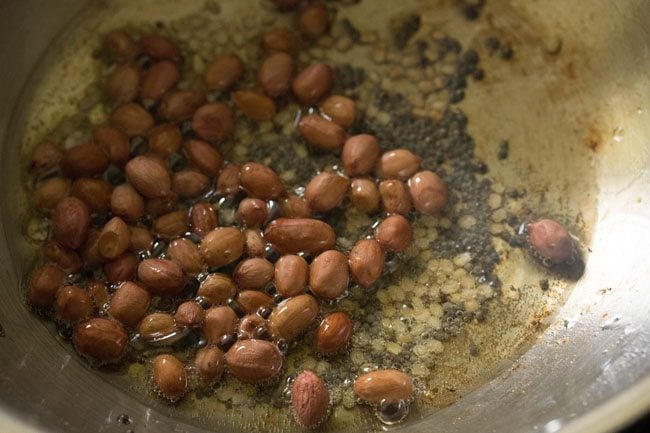
10. Sauté till the urad dal becomes golden.
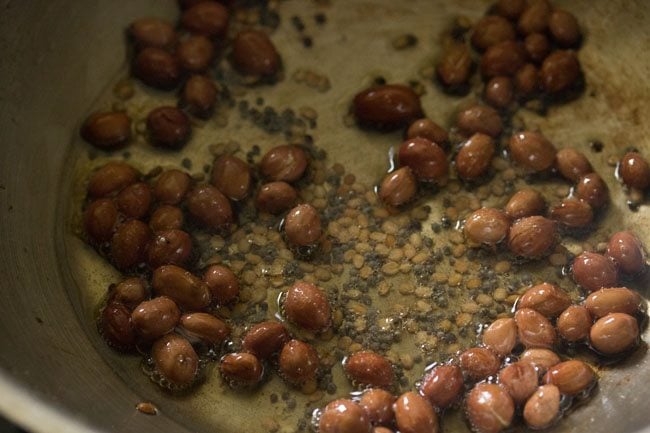
11. Next, add 1 to 2 dried red chilies, 1 sprig curry leaves or 10 to 12 curry leaves and ⅛ teaspoon asafoetida (about 2 pinches asafoetida).
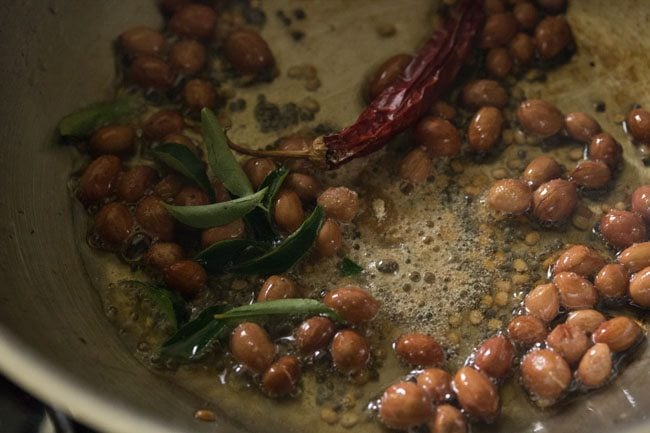
12. Add the brinjal pieces. Remove them from the salted water and add to the pan. Be careful as the mixture splutters when adding brinjals.
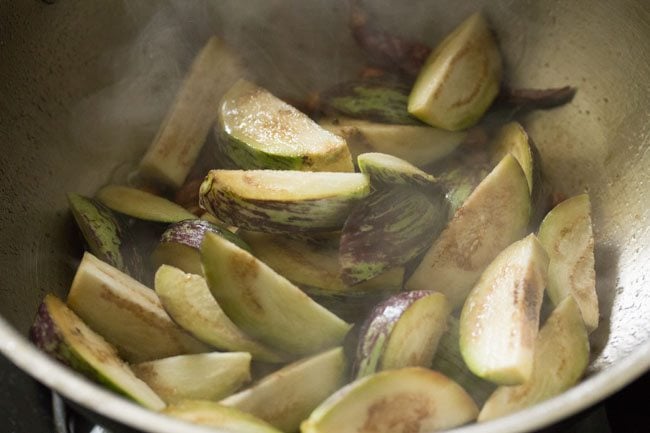
13. Mix them with the rest of the ingredients.
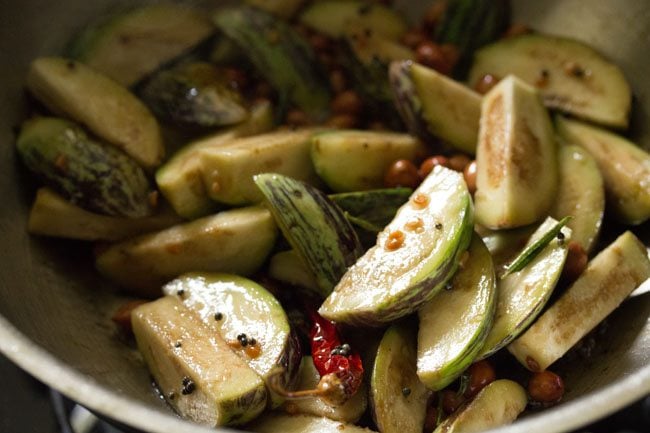
14. Add ¼ teaspoon turmeric powder and salt as per taste.
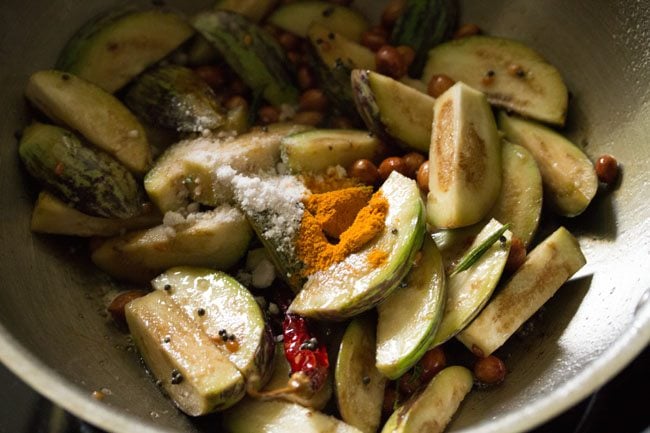
15. Mix the turmeric powder and salt very well.
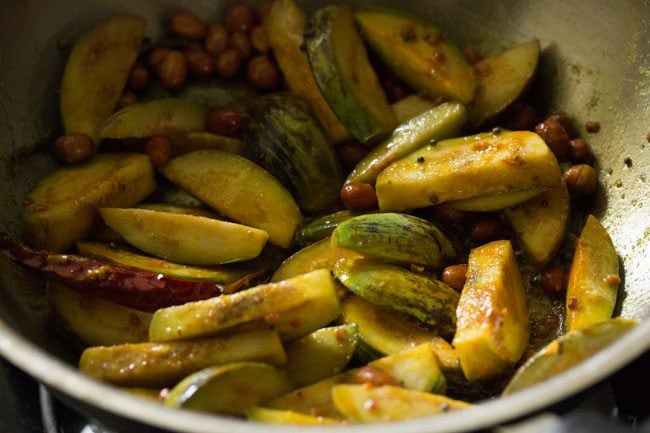
16. Cover the pan with a lid and let the brinjals get half-cooked. Check at intervals. If the brinjals start sticking to the pan while cooking, add some water. Then, cover and cook.
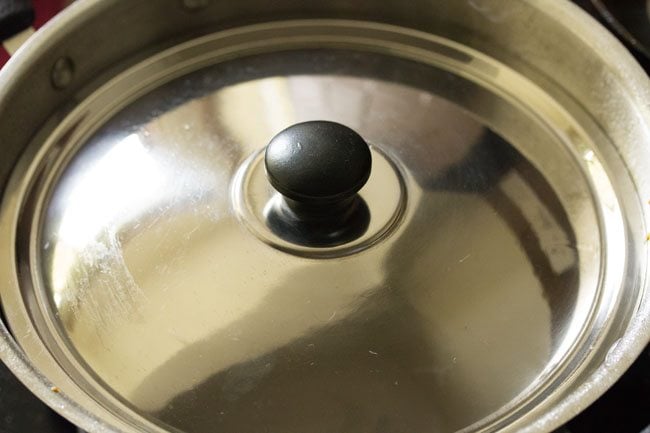
17. Half cook the brinjals.
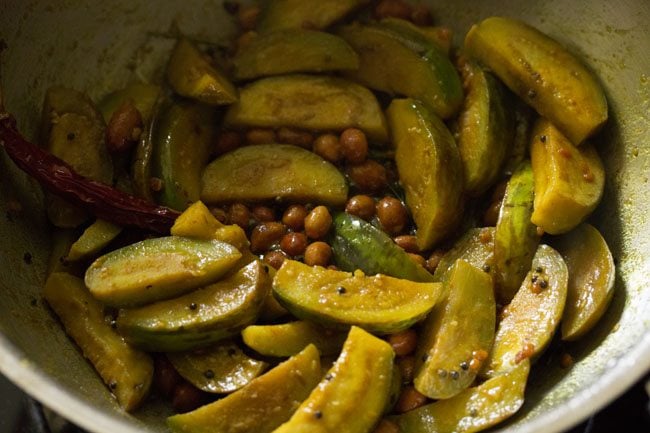
18. Once half done, add the tamarind pulp.
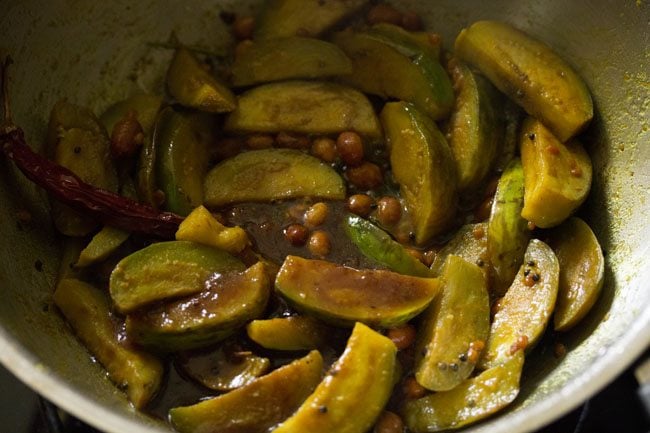
19. Then, add 2 to 2.5 tablespoons Vangi Bath masala powder.
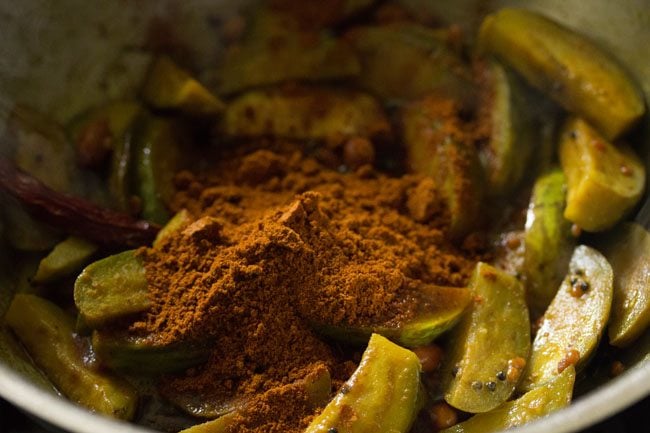
20. Mix well and continue to cook without the lid. If the masala along with brinjals starts sticking to the pan, then add ¼ cup water and continue to cook.
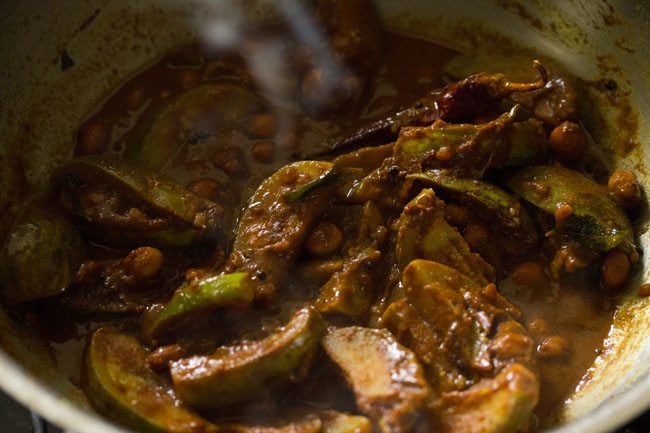
21. Once the brinjals are cooked well, add 2 tablespoons grated fresh coconut and ¼ to ½ teaspoon jaggery powder.
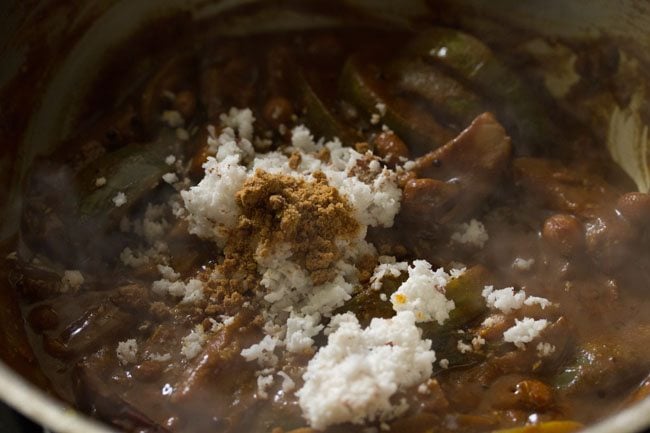
22. Mix well, once again. The brinjal masala is thick. But for some moisture you can have a semi gravy consistency in the brinjal masala. Check the taste and you can add some more jaggery powder or salt if you want.
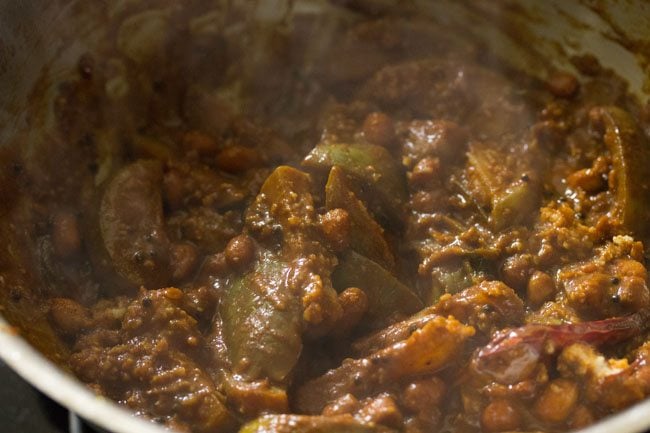
23. Remove the pan from heat and add rice in 2 to 3 parts. Mix gently.
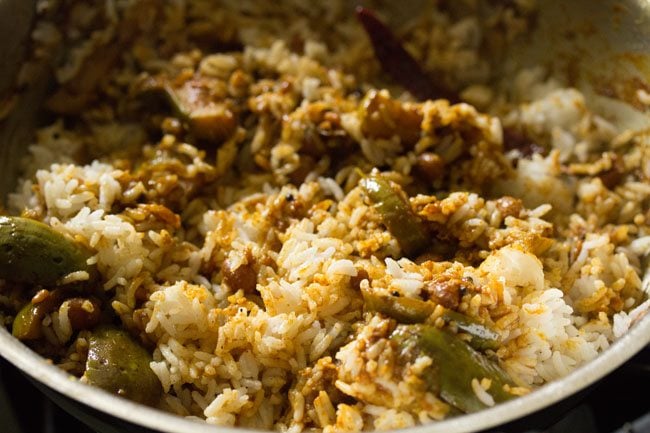
24. Add the next portion of rice and then mix well.
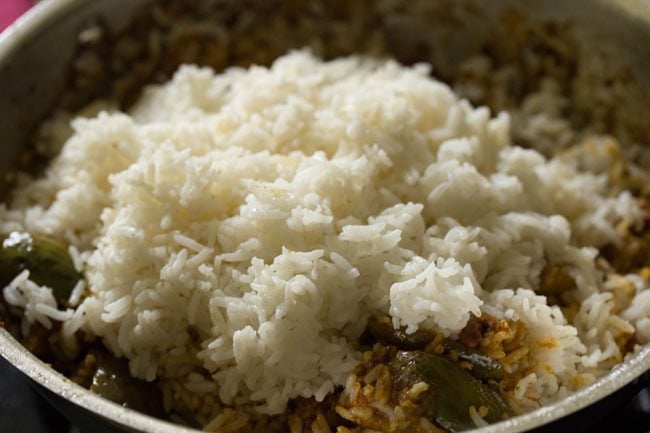
25. Stir gently, so that everything is mixed evenly.
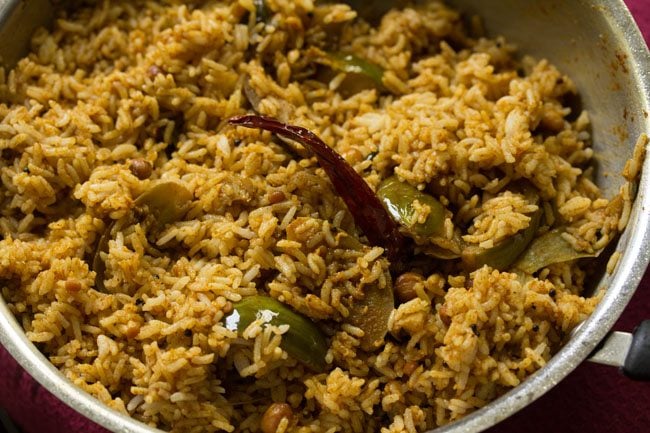
26. Serve Vangi Bath, Karnataka style with raita, papads or chips.
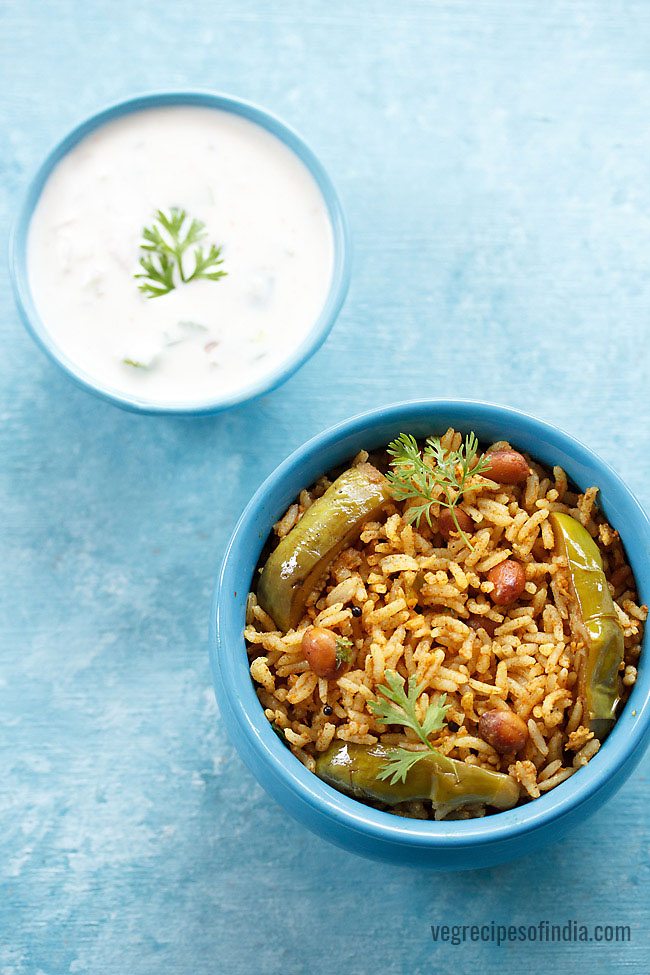
Please be sure to rate the recipe in the recipe card or leave a comment below if you have made it. For more vegetarian inspirations, Sign Up for my emails or follow me on Instagram, Youtube, Facebook, Pinterest or Twitter.
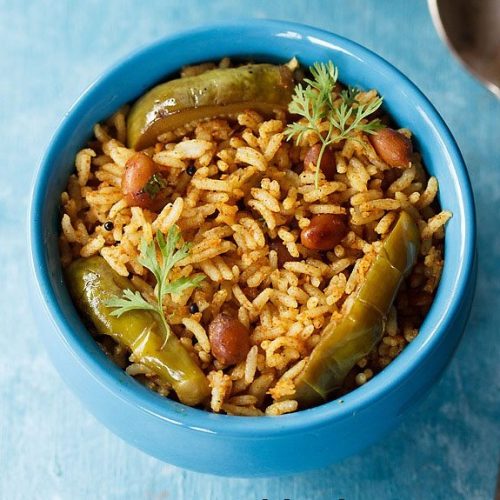
Vangi Bath (Brinjal Rice)
Vangi bath is a delicious recipe of brinjal rice from the Karnataka cuisine. This Vangi bath recipe makes use of vangi bath masala powder and tamarind pulp as two of the main ingredients.
Prep Time 30 minutes
Cook Time 20 minutes
Total Time 50 minutes
for cooking rice
for preparing tamarind pulp
other ingredients
preparation
First soak 1 heaped cup rice in water for 30 minutes. Use any regular rice. I used sona masuri rice.
Then pressure cook the rice with 2 cups water, ¼ teaspoon salt for 3 to 4 whistles on a medium flame or for 11 to 12 minutes. You can also cook the rice in a pot. If cooking in a pot, then you may need to add more water.
Soak ½ tablespoon tightly packed tamarind in ¼ cup hot water for 20 to 30 minutes.
Later squeeze the soaked tamarind in the water to get the tamarind pulp. Strain and keep aside.
When the pressure settles down on its own, open the cooker’s lid and fluff the rice.
You can allow the rice to cool in the cooker itself or spread rice on a large plate/thali or tray. Allow the cooked rice grains to become warm or cool down. Cover and keep so that the rice grains do not dry out.
When the rice is cooking, rinse the brinjals. Remove the crowns of the brinjals and slice them vertically in 4 long pieces. As soon as you chop them, place them in a bowl containing water to which some salt has been added.
Do make sure that there is sufficient water covering the brinjals. Allow them to be in the salted water for 15 to 20 minutes.
making vangi bath
Heat 2 tablespoons peanut oil (can also use sesame oil or sunflower oil) in a pan or kadai.
Add ½ teaspoon mustard seeds.
Once the mustard seeds begin to crackle, then add ½ teaspoon urad dal.
Next add 2 tablespoons roasted peanuts or cashews.
Saute till the urad dal becomes golden.
Then add 1 to 2 dry red chilies, 1 sprig curry leaves or 10 to 12 curry leaves and ⅛ teaspoon asafoetida (about 2 pinches of asafoetida).
Add the brinjals. Just remove the brinjals from the salted water and add in the pan. Be careful as the mixture splutters when adding brinjals.
Mix them with the rest of the tempering mixture.
Add ¼ teaspoon turmeric powder. Also add salt as per taste.
Mix the turmeric powder and salt very well.
Cover the pan with a lid and let the brinjals get half-cooked. Do check at intervals. While cooking, if the brinjals start sticking to the pan then add some water. Then cover and cook.
Half cook the brinjals.
Once they are half done, then add the tamarind pulp.
Then add 2 to 2.5 tablespoons vangi bath masala powder.
Mix very well and continue to cook without the lid. If the masala along with brinjals start sticking to pan, then add ¼ cup water and continue to cook.
Once the brinjals are cooked well, add 2 tablespoons grated coconut and ¼ to ½ teaspoon jaggery powder.
Mix again very well. The brinjal masala is thick. But for some moisture you can have a semi gravy consistency in the brinjal masala.
Keep the pan down and add rice in two to three parts. Mix gently.
Add the next portion of rice and then mix well.
Mix gently but very well so that everything is mixed evenly.
Serve vangi bath with raita, papads or chips.
Nutrition Facts
Vangi Bath (Brinjal Rice)
Amount Per Serving
Calories 687 Calories from Fat 198
% Daily Value*
Fat 22g34%
Saturated Fat 5g31%
Sodium 1523mg66%
Potassium 549mg16%
Carbohydrates 106g35%
Fiber 9g38%
Sugar 7g8%
Protein 13g26%
Vitamin A 430IU9%
Vitamin C 134.6mg163%
Calcium 79mg8%
Iron 2mg11%
* Percent Daily Values are based on a 2000 calorie diet.
About Vangi Bath, Maharashtrian style
The main ingredients in the Maharashtrian style Vangi Bath recipe are the exclusive goda masala, curd and tomatoes along with the aubergine and rice. I also used a typical ambe mohur rice for the bath in this vegan Brinjal Rice. You can use any other variety of basmati rice.
This popular one-pot spiced rice dish is made in a similar way as the Masale Bhat or Tondli Bhaat (ivy gourd rice). The traditional spice blend goda masala gives the Maharashtrian Vangi Bath a distinct taste and aroma.
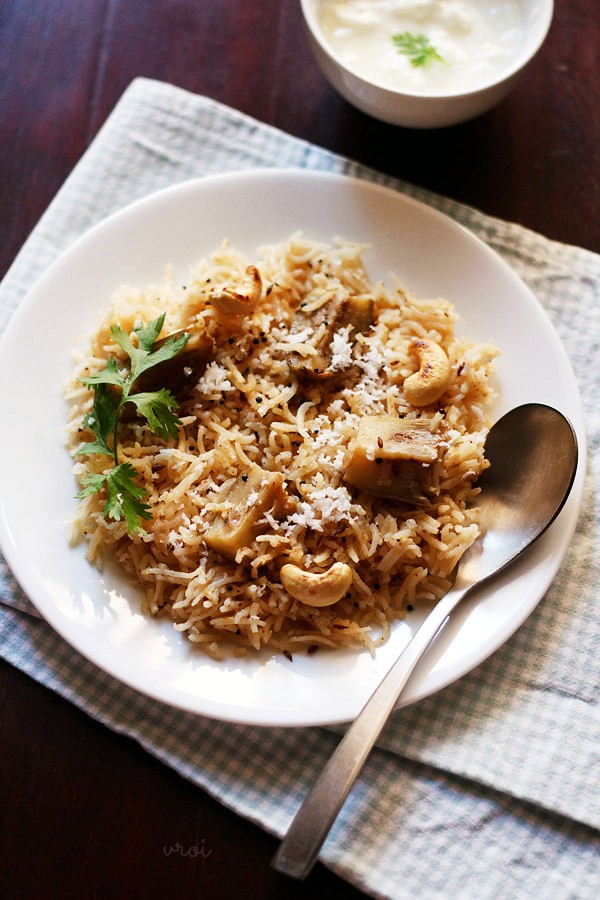
It is best to freshly grind the spices to prepare the goda masala and avoid using a store-bought one. But in case you have a readymade goda masala powder at home, skip the grinding of the spices in this Vangi Bath recipe.
This recipe of Vangi Bath has onion, but you may skip it. When doing so, add a pinch of asafoetida or hing in the tempering, instead. Relish it plain or with a bowl of curd or raita.
Just like its counterpart from Karnataka, this Maharashtra special Brinjal Rice is also nutritious and relatively easy to prepare. The extra time that you need to is to prepare the goda masala, and that is about it.
I have used a kadai to cook the rice. Cook in a pressure cooker, to make it even faster. If doing so, add about 2.5 to 2.75 cups water and pressure cook for 2 to 3 whistles.
What is goda masala
You can refer to the goda masala as the Maharashtrian version of the ubiquitous garam masala. Goda masala has a complex nature when it comes to flavors and depth.
Hence, this regional spice blend is a classic way of bringing in sweet, pungent taste and a beautiful aroma in many dishes of the food culture of Maharashtra. This masala has a mix of some basic spices and some unique ones that you might have to specially source.
In this Maharashtrian Vangi Bath recipe, I may have skipped a few ingredients to make the goda masala. But for an authentic recipe, this Goda Masala is what you can refer to anytime. All you have to do is roast the spices on low heat, let them cool and then grind to a fine powder.
Step-by-Step Guide
How to make Vangi Bath (Maharashtrian style)
Making goda masala
1. On a low flame in a small frying pan, dry roast the whole spices till they are aromatic. The spices are – 1 small bay leaf, 1 small piece stone flower (dagad phool), 2 teaspoons coriander seeds, 1 dried red chili, 1 teaspoon cumin seeds, 3 cloves, 1 inch cinnamon, ½ teaspoon caraway seeds (shahi jeera), 4 black peppercorns and 1 pinch asafoetida (hing).
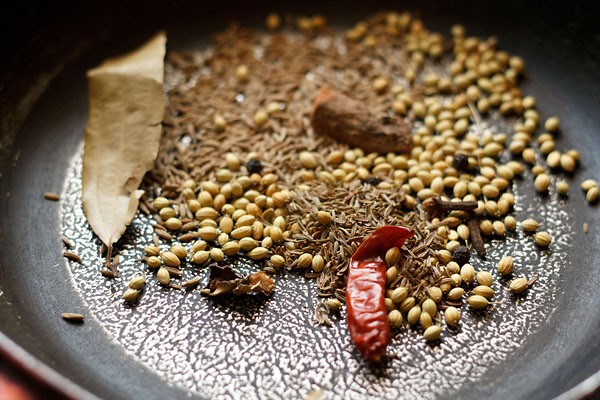
2. Bring the roasted spices to the side of the pan and add 1.5 tablespoons unsweetened desiccated coconut and 1.5 tablespoons white sesame seeds.
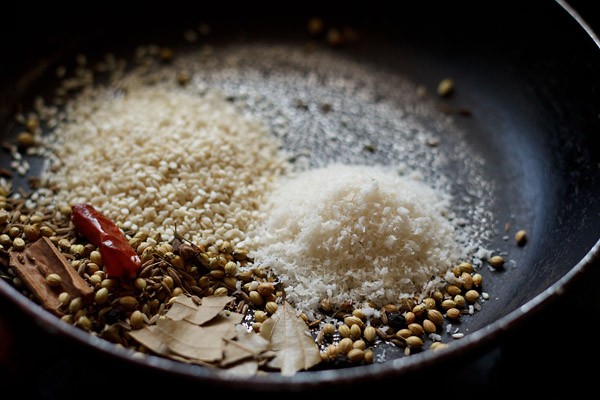
3. Stir and continue to dry roast till the coconut becomes golden. Keep stirring regularly so that the coconut does not burn. Let this spice and coconut mixture cool.
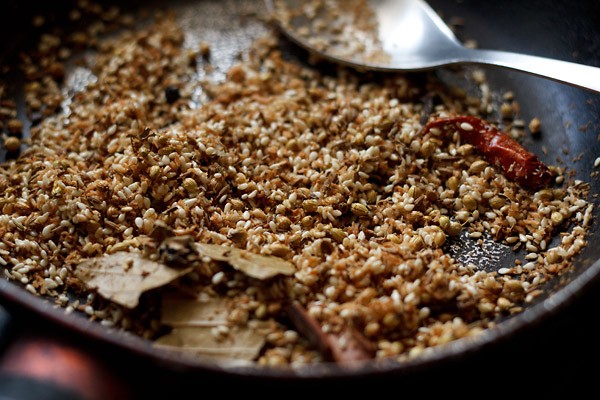
4. Once the roasted spices-coconut-sesame seeds mixture is cool, grind to a fine powder in a dry grinder or coffee grinder. Only 2 to 3 teaspoons of the goda masala (as per your taste) needs to be added to the rice. The remaining goda masala can be refrigerated and added to vegetable dishes or lentils.
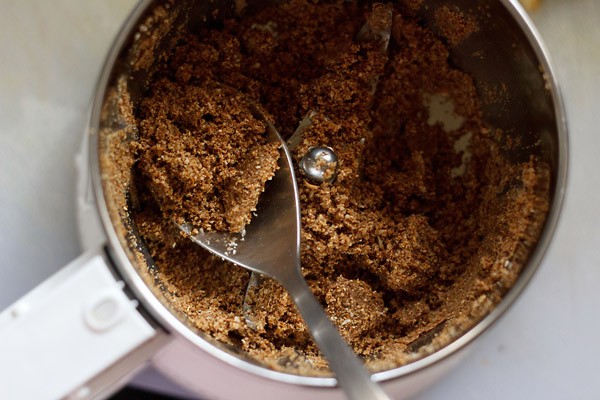
Soaking rice and brinjals
5. Soak 1.5 cups rice in water for 30 minutes and then drain. Keep aside. You can add basmati rice, ambe mohur rice (mango blossom rice) or even sona masuri.
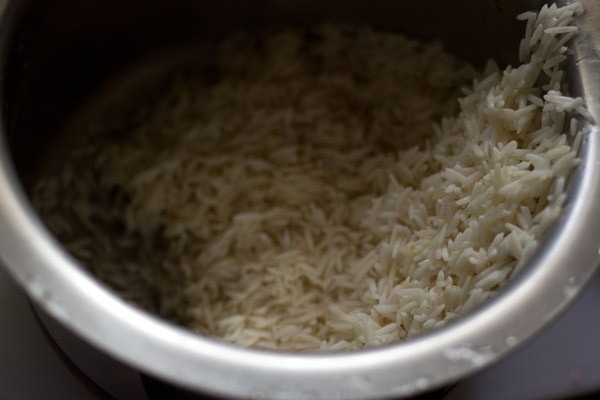
6. Quarter or chop 4 to 5 medium brinjals (vangi). Keep the chopped brinjals in a bowl of salted water for 15 minutes. This avoids the discoloration and gets rid of the bitterness from the brinjals, if any.
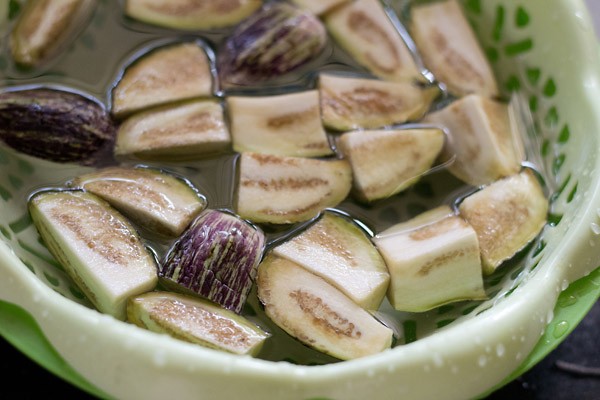
Making Vangi Bath, Maharashtrian style
7. Heat 2 tablespoons peanut oil in a large thick bottomed pan. First, splutter ¾ teaspoon mustard seeds and ¾ teaspoon cumin seeds.
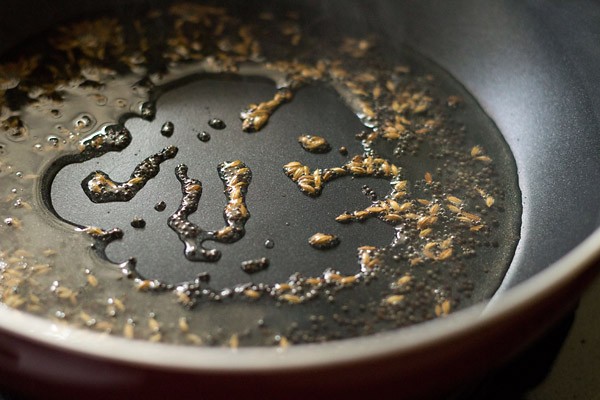
8. Then, add 1 medium finely chopped onion and sauté till it turns translucent.
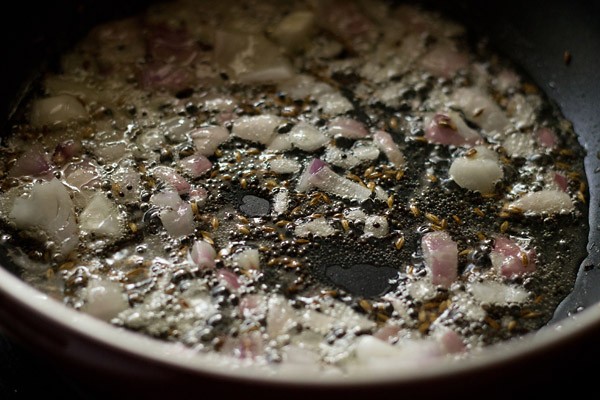
9. Add 6 to 7 curry leaves and 1 chopped green chili. Stir.
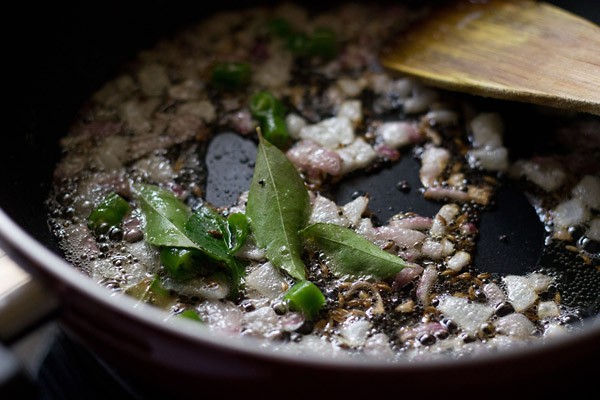
10. Then, add the drained brinjals (vangi) along with ¼ teaspoon turmeric powder. Stir and sauté for 3 to 4 minutes.
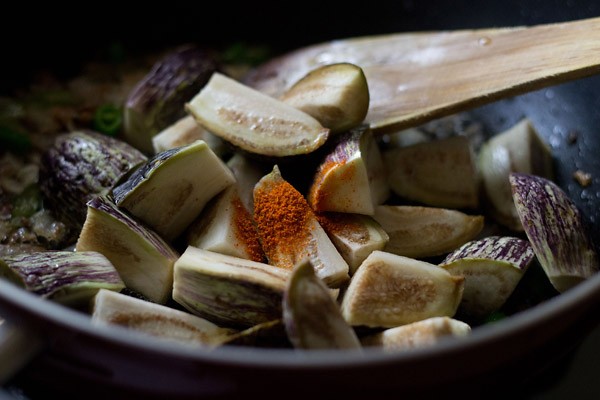
11. Stir and add the soaked rice, 2 to 3 teaspoons of the prepared goda masala and 2 tablespoons curd.
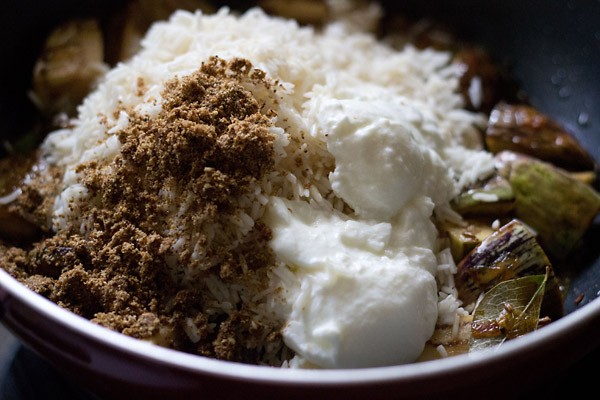
12. Stir and pour 3 cups water. Season with salt as required.
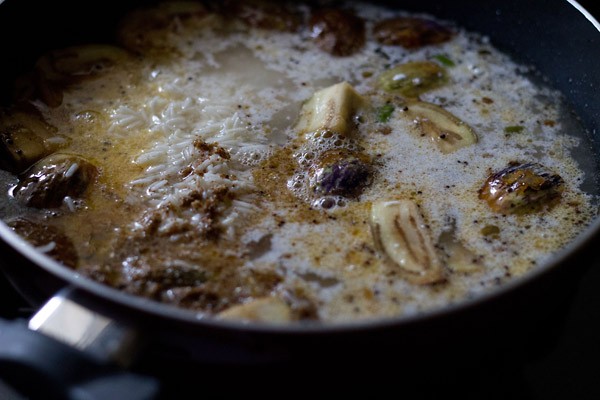
13. Stir very well.
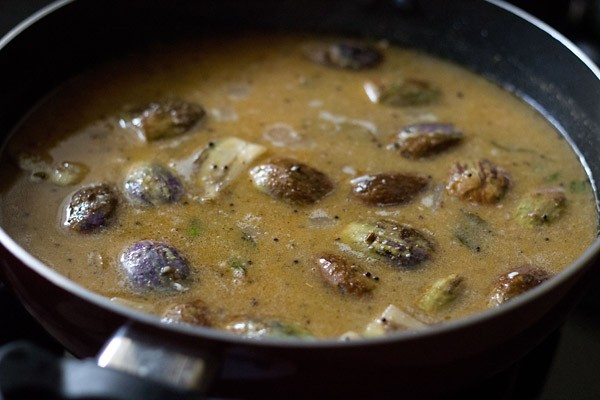
14. Cover with a lid and cook the rice on low heat till the grains are tender and cooked.
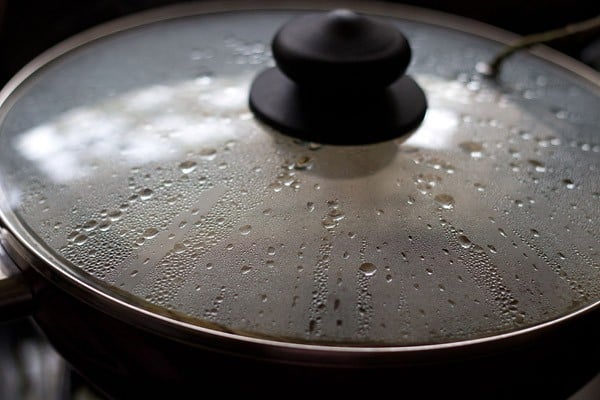
15. Meanwhile, roast 15 to 18 cashews in a pan till they get some brown spots on them. You can also add peanuts instead of cashews. Roast them in the same way.
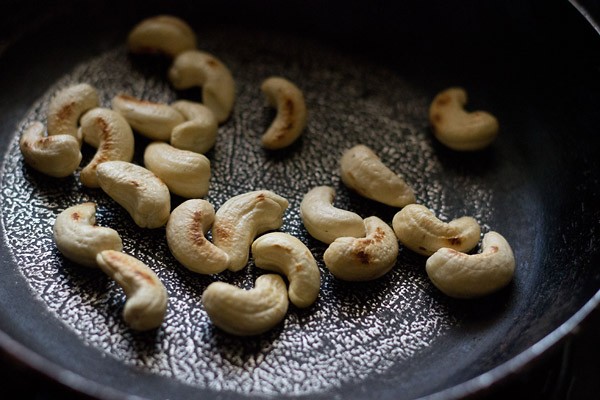
16. Once the rice is cooked, fluff gently.
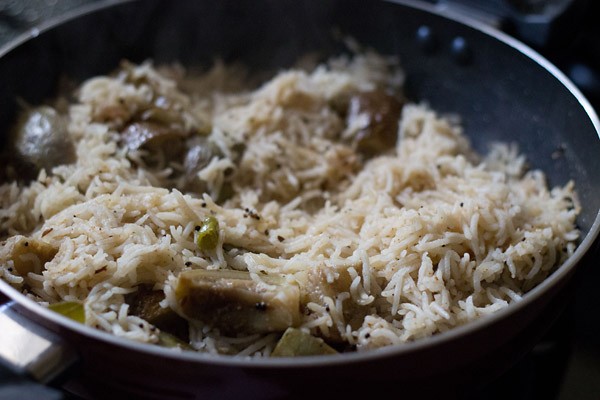
17. Add 1 tablespoon grated fresh coconut, ½ tablespoon chopped coriander leaves and the roasted cashews. Mix gently.
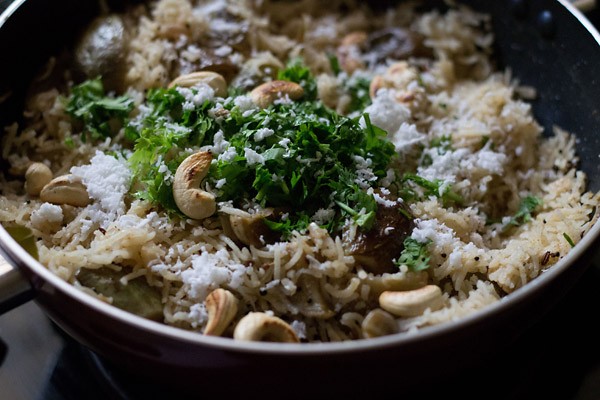
18. Serve Maharashtrian style Vangi Bath hot or warm plain or with curd or raita. You can also top with a bit of ghee while serving.
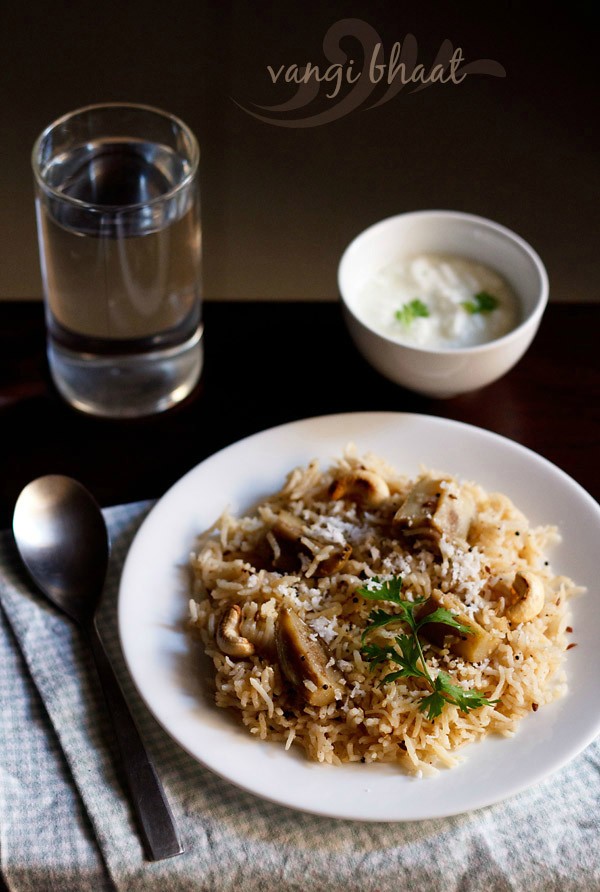
More Rice Recipes To Try!
Rice Recipes
Karnataka Recipes
Rice Recipes
Rice Recipes
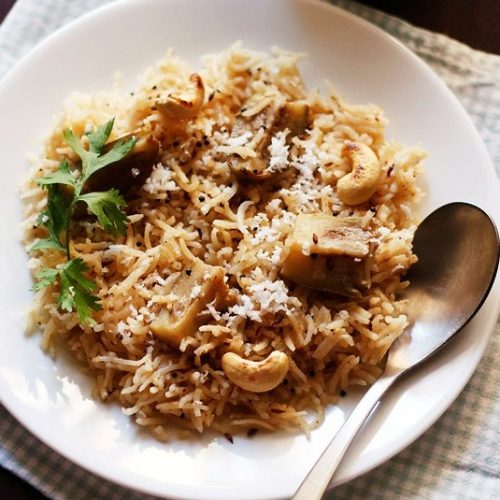
Vangi Bath
Maharashtrian vangi bhat or vangi bath is a one-pot meal dish of spiced rice made with brinjal and freshly ground spices.
Prep Time 30 minutes
Cook Time 40 minutes
Total Time 1 hour 10 minutes
for the goda masala
remaining ingredients
making goda masala
On a low flame in a small frying pan, dry roast the whole spices mentioned under the list “for the goda masala”, except sesame seeds and desiccate coconut. Roast the spices till they become aromatic.
Then add the desiccated coconut and sesame seeds and continue to dry roast till the coconut becomes golden. Keep stirring regularly so that the coconut does not get burnt. Let this spices cool.
Once the roasted spices + coconut mixture gets cooled, grind them fine in a dry grinder or coffee grinder.
Keep this small batch of goda masala aside and just add about 2 to 3 tsp of it in this recipe. The remaining goda masala can be kept in the fridge in a small bowl or box and added to veggie dishes or dal.
soaking rice and brinjals
Rinse the rice for a few times in water. Then soak the rice in water for 30 minutes and then drain them. Keep the soaked rice aside.
Quarter or chop the brinjals (vangi)
Keep the chopped brinjals in a bowl of salted water for 15 minutes. This soaking does not discolor them and gets rid of the bitterness if any.
making maharashtrian style vangi bath
Heat oil in a large thick bottomed pan and splutter the mustard seeds and cumin seeds.
Then add onions and saute till the onions turn translucent.
Add curry leaves and green chilies. Stir.
Then add the drained brinjals (vangi) along with turmeric powder.
Stir and saute 3 to 4 minutes.
Then add the soaked rice, 2 to 3 tsp of the freshly ground goda masala and yogurt.
Stir and pour water. Season with salt. Again stir very well.
Cover with a lid and cook the rice on a low flame till the grains are tender and cooked.
In case the rice has not cooked and the water has dried, add some water and stir gently and continue to cook the rice.
Meanwhile, roast cashews in a pan till they get some brown spots on them. Instead of cashews, you can also add peanuts and roast them in the same way.
Once the rice is cooked, fluff gently.
Add grated coconut, chopped coriander leaves and the roasted cashews. Mix gently.
Serve vangi bath plain or with raita hot or warm.
You can also garnish it with coriander leaves and grated coconut while serving.
- For cooking in a pressure cooker – add about 2.5 to 2.75 cups water and pressure cook for 2 to 3 whistles.
This Vangi Bath recipe from the archives was first published in November 2016. It has been updated and republished in February 2024.

